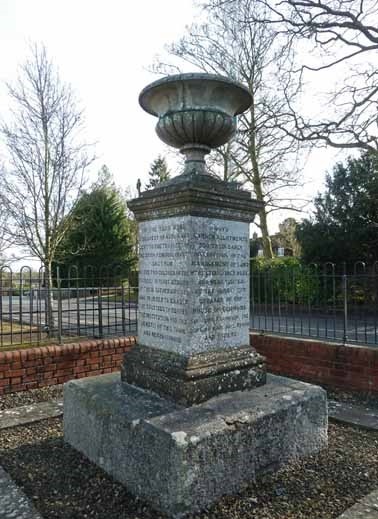Of the many greatly acclaimed individuals in Southam’s history Dr Henry Lilley Smith, who developed the Eye and Ear Hospital in Warwick Road, was one of the most distinguished. On the edge of the car park at Warwick House, which was once the hospital, there is a memorial to him.
His grandfather Lilley Smith, who was born in Southam in 1787, was a master grocer in Coventry who owned land and buildings in Coventry city centre and at Napton-on-the-Hill. Henry’s father William Lilley Smith married at St James’ Church a local woman, Sophia Chambers. Sophia’s family were connected to Coventry as drapers, and her father was a Southam grocer and gentleman. The Warwick Road land was left to Henry’s mother as a bequest from her uncle George Pearson, allowing Henry to make his family home there and to develop the Eye and Ear Hospital in 1818.
Prior to that date, while studying in London in 1809 Henry volunteered as an Assistant Surgeon to attend the many wounded troops returning to Colchester Barracks from service under Sir John Moore at Corunna, Spain, in the Napoleonic Wars. He returned to Southam and was appointed the parish surgeon, his army experiences having broadened his knowledge of life. His views and ideas were ahead of his time and inspired him to develop the Eye and Ear Hospital in what is now Warwick House in 1818, and the self-supporting Dispensary in the grounds in 1823. In an article of 1850 in the London Medical Journal he wrote:
“ … I was for a short time attached to the army; and there acquired those ideas of order and discipline … ” with which he ruled the hospital.
Henry kept a well-ordered hospital, strongly arguing his outspoken ideas despite extensive surrounding criticism, but after his death in 1859, his son the Reverend William Lilley Smith struggled to maintain it financially. The Trustees then changed it from a specialist hospital to a general Cottage Hospital. One could say this was the final nail in the coffin, because without Henry Lilley Smith’s leadership, the Institution began to fail. All Henry’s hard work slipped away and at his son’s death in 1895, despite William’s bequest establishing the Hospital as a sanatorium and nursing home in connection with the Warneford Hospital in Leamington Spa, the building was sold as a private residence and the hospital was finished.
One of Southam’s recent doctors, Dr Alastair Robson, has researched the Eye and Ear Hospital and written the story behind it in more depth. His book, entitled A Prophet in his own Country, is now available, and the Southam Heritage Collection’s summer exhibition from June to October features the story of the Hospital and Henry Lilley Smith. The displays feature items from the medical bag of Dr Smorfitt,, one of Southam’s earlier 20th century doctors. Looking at medical instruments such as Dr Smorfitt’s old syringes makes one very aware of how far medicine has progressed in such a short time.
Southam Heritage Collection is located in the atrium of Tithe Place opposite the Library entrance. We are open on Tuesday, Thursday, Friday and Saturday mornings from 10am to 12 noon. To find out more about Southam’s history, visit our website www.southamheritage.org, telephone 01926 613503 or email southamheritage@hotmail.com You can also follow us on Facebook.


Leave A Comment